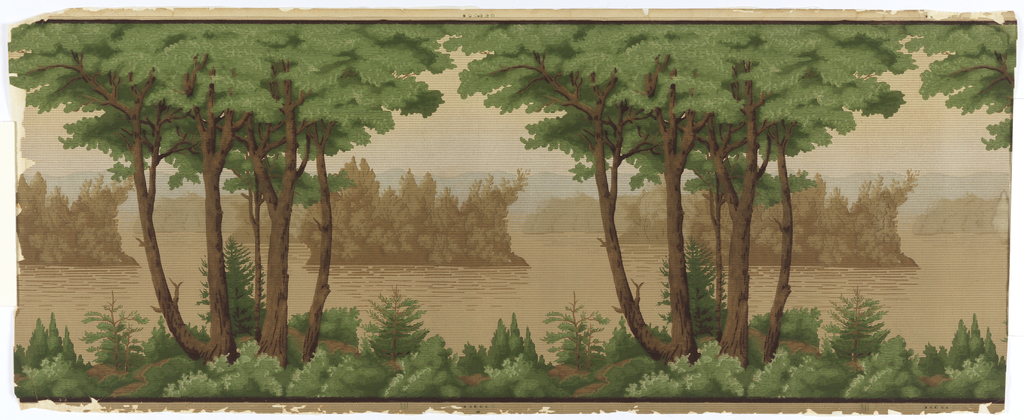Wide landscape friezes were popularized by Walter Crane in 1896 and remained in vogue until around 1913. The use of these friezes led to a more simplified wall treatment in the Mission interior, and even though multiple patterns were still being used on a wall, the frieze became the dominant element. Wide friezes were usually hung at the top of the wall where the perspective shown in the landscapes visually expanded the size of the room. A coordinating sidewall paper in a solid color or tone-on-tone pattern that matched a dominant color in the frieze would run from the baseboard to the bottom of the frieze. A narrow wood molding normally separated the two papers. Landscape friezes were also popular in dining rooms where it was common to hang the frieze at eye level, with a sidewall paper rising up to meet it, with the intersection of the two covered with a plate rail molding. The ceiling paper could then be brought down to the top of the frieze.
Even with the advances made in the high-speed printing machines, machine-printing was seen as a lesser form of printing through most of the nineteenth century. One reason for this was that machine-printed papers had smaller repeats than block prints: the standard 6-inch roller printed an 18 inch repeat. While the repeat of a block print could be any size, the hand printing also afforded the option of alternating motifs or design elements as you printed down the length of paper. The design was not limited to what could be carved onto a 6 inch roller. Many critics saw these small repeats as a flaw and felt that having one scene or motif repeating endlessly around the room would be monotonous and not be engaging to the viewer. Some manufacturers got resourceful and tried to disguise the small repeat or at least make it appear more varied. If you look at the green trees in the foreground of this frieze, each clump is identical, as are the brown trees in the background. What makes this interesting is that the repeat size of the foreground is larger than the repeat size of the background. The manufacturer used two sets of rollers to print this, one set larger than the other. When you look through the green trees, the landscape view in the background changes with each repeat, making the repeat appear more random.

One thought on “Wallpaper that Expands Your Horizons”
Kathy Herbers on July 21, 2019 at 11:29 am
Recently acquired 3 patterns with a total of 7 rolls of similar landscape frieze marked The Robert Graves Co. Please contact me about these.